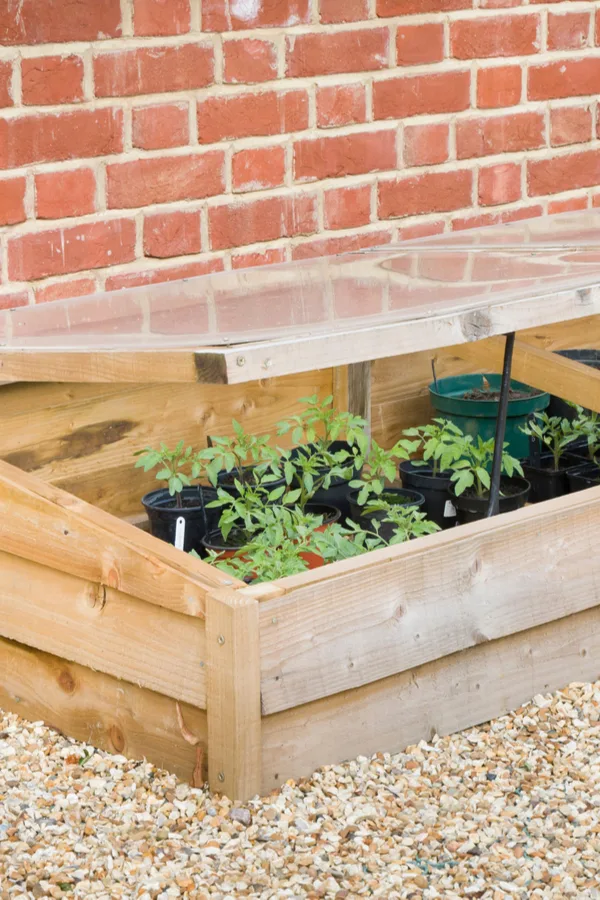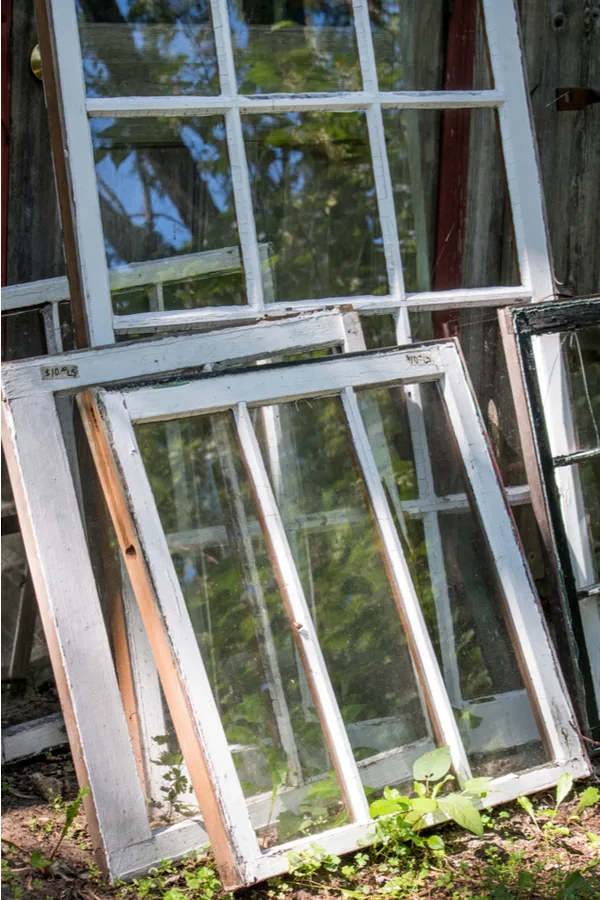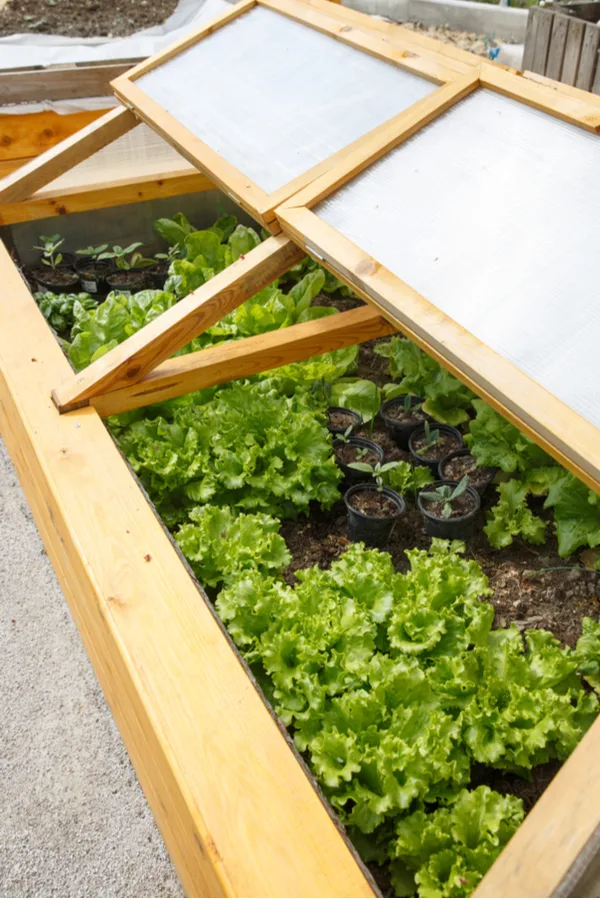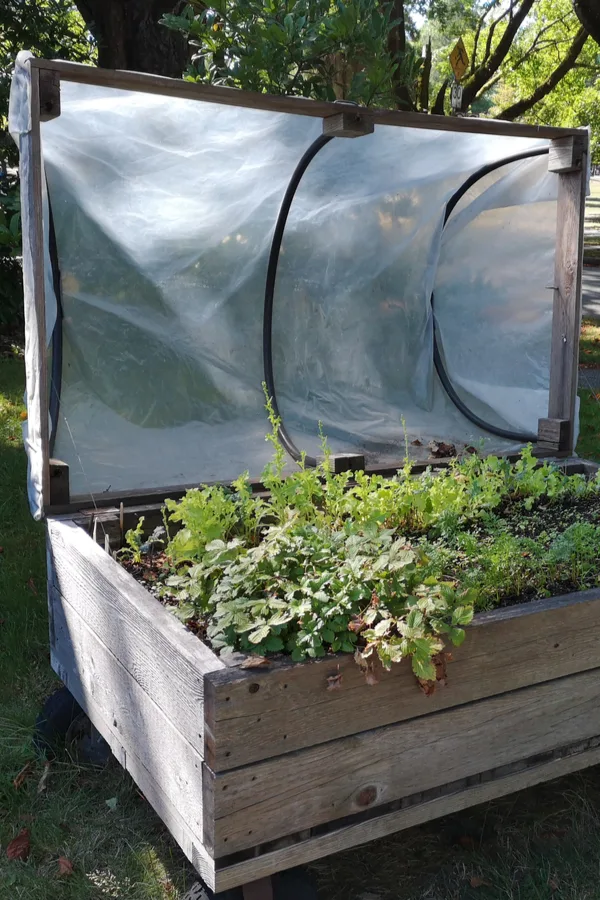If the fall and winter months have you feeling a little down and bored because your vegetable growing season has come to an end, don’t fret! Using a cold frame might be just what you need!
Cold frames are a great way to extend the length of your growing season when typical outdoor temperatures drop too low for plants to survive. The purpose of a cold frame is to trap in the heat from the sun’s rays while also protecting plants from outdoor elements such as wind, rain, and snow.

Depending on your location and the type of cold frame you use, you can extend your growing season by several weeks if not months. And it’s not just vegetables that can be grown in a cold frame.
Cold frames can also be used to help harden off your indoor started transplants before planting them in the garden. In addition, they are a great way to grow sprouts or store plants when an unexpected late frost arrives in early spring.
Using A Cold Frame
How A Cold Frame Works
A cold frame is basically a four-sided structure that has a clear lid or top and has soil at the bottom. The sides help to keep cold temperatures out while also protecting the plants from the elements.
The clear top allows the sun’s rays and heat to become trapped inside. This helps to heat the surrounding air and soil inside the cold frame, allowing the plants to grow even when temperatures outside drop.
Types Of Cold Frames – Using A Cold Frame
Almost any type of material can be used to construct a cold frame. Most often, simple 2x boards are used. However, you can even use metal, plastic, cement blocks, bricks, or even straw bales.
When using lumber, try to choose hardwood instead of softwood that will be able to stand up to the harsh winter elements a bit better. Also, make sure not to use treated lumber, especially if the boards are going to be in contact with the soil and plants.
Using straw bales is one of the easiest methods to use. Simply stack them into whatever shape you want, add the clear lids, and you will be good to go. In addition to being easy to set up, straw bales are excellent at providing great insulation against the cold.
The lid of the cold frame can be anything from old window frames, plastic sheeting, plexiglass, or any clear glass. Most are hinged at the back while others are made to be removable. You will need to be able to prop the lid open either way to allow excess heat escape if needed, so keep that in mind when constructing a cold frame.

Going Simple
You can even create mini, temporary cold frames by cutting off the bottoms of milk jugs to place over a single plant or two. Just keep in mind that milk jugs won’t really insulate your plants during harsh winter conditions. You might still be able to prolong your growing season a few weeks in the fall though simply by keeping plants protected from the elements or early frosts/freezes.
To help control the temperature or humidity inside the jug, simply open or close the lid (more on regulating temperatures later). Milk jugs also work excellent for protecting new transplants in the early spring.
Placement Is Everything
For maximum benefit, you need to build your cold frame so it faces South. This will allow the cold frame to get the most amount of the sun’s rays as possible, especially in the shorter winter months.
While you can lay the cold frame’s lid flat, you will be able to absorb more of the sun’s rays if you angle the lid about 10 to 15 degrees to the South. This allows the early morning sun’s rays to shine through the lid. It also allows more of the heat to be absorbed before it starts to cool down during the night. Every little bit counts when the daylight hours are short and the nighttime temperatures are low!
The Growing Medium
There are many options when it comes to the base of your cold frame. While you may wish to build a base onto the frame, the easiest option is to lay the four walls directly on top of the soil.
You can place your cold frame directly in your garden on top of the already loosened soil if you wish. Or, make the most out of your space and attach a cold frame lid to your pre-made raised garden beds. Making a simple frame out of PVC pipes or thin lumber and then attaching plastic sheeting works excellent for this.
Another option would be to create a stand-alone cold frame. Just make sure to fill the structure’s base with a good mixture of compost, garden soil, and potting soil. This will create a nice, nutrient-rice and loose growing medium for crops to grow in. (To learn how you can create your own amazing compost to add to your cold frame, check out “Learn How To Compost Like A Pro.”)
A quick tip: Make sure you add your soil or set the cold frame on top of your garden soil a few weeks before you are going to plant. This allows the soil to warm up a bit, helping speed up the germination process.
If you are planning on only having only potted plants in the cold frame, the base of the frame doesn’t really matter as much. However, it might be useful to add a layer of straw for additional insulation since potted plants won’t be as protected as in-ground plants.

What Can You Grow When Using A Cold Frame?
Some crops are going to do better than others in cold frames. It will largely depend on your growing zone and whether you have cold winters or not. Locations that experience cold winters will have the best luck using cold frames.
Fast-growing, cold-weather plants will be your easiest crops to grow in cold frames. Crops such as spinach, kale, radishes, and most all types of lettuces are excellent choices. These types of crops thrive when temperatures are a bit cooler and they are also fast growers. Other cold-weather crops that might work include turnips, green onions, rutabaga, brussel sprouts, broccoli, cabbage, and peas.
You will want to take the plant’s mature size into consideration when choosing what types of crops to grow. For example, if you have a smaller cold frame that is only a couple of feet tall, you won’t want to plant a crop that can grow to be 3 feet tall.
Controlling The Temperature
The biggest struggle with using a cold frame is trying to control the temperature inside. While they are useful at keeping the cold temperatures and elements out, it is possible to overheat the air and soil in a relatively short period of time.
To help control this issue, you need to be able to prop open the lid on warm days. This helps to prevent the plants from baking inside the cold frame as well as allowing excess moisture to escape. Even propping open the lid by a few inches will be enough to help control the inside temperature.
There are even devices that you can attach to your cold frame to help regulate the temperature without the need for constant checking. Solar versions are available that will operate without the use of an alternative power source. (Product Link : Automatic Vent Opener)
Depending on what temperature you set it at, it will automatically open and close when temperatures are anywhere above or below 55 to 75º Fahrenheit (12 to 24º Celsius).
If you don’t want to use an automatic opener, you can open and close the lid the old-fashioned way. But it might be useful to keep a thermometer inside the cold frame to get a quick read of the interior temperature.
Season-By-Season Guide
In addition to just extending your growing season during the colder weather months, cold frames have other uses. Take a look at how you can use your cold frame no matter what season you are in.
Fall
Using a cold frame in the fall is a great way to extend your warm-weather summer crops by several weeks. If your frame is portable, place it over sensitive plants to keep them safe from fall frosts and dipping temperatures. You can also start any new cold-weather crops inside a cold frame during the autumn months.
Winter
If temperatures allow, continue to grow your cold-weather crops. You can also use cold frames to overwinter more sensitive perennials. Fill cold frames with thick layers of straw to store winter root vegetables such as potatoes, carrots, parsnips, or beets. Be careful not to allow the soil to freeze and be mindful of excess moisture.

Spring
Begin another planting of cold weather crops or continue growing those from Winter. In addition, you can also start cold-weather root crops from seed to plant outdoors or for more harvesting.
Once harvesting of your cold-weather crops is complete, you can start your warm-weather seeds. Crops like tomatoes, peppers, squash, melons, and beans all work well when started in cold frames.
Your cold frames are also great for hardening off your indoor planted seedlings. By venting your cold frame, you can begin to acclimate your seedlings to outdoor temperatures and conditions. Gradually raise the lid to give them more and more exposure to the elements.
Summer
Continue starting warm-weather seeds in the cold frame to allow for succession planting. (For more information about succession planting, listen to Succession Planting – How To Get The Most From Your Garden Space.) If possible, you can also remove the lid and use it like a raised bed planter. Cold frames are also a great place to store your root cuttings.
To Conclude…
Using a cold frame is an excellent way to get extend your gardening season. With just a little bit of work and preparation, you can enjoy your vegetable crops all year long!
